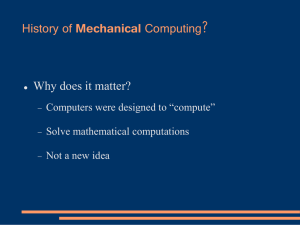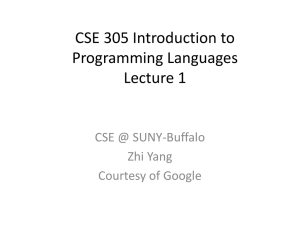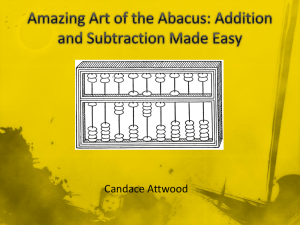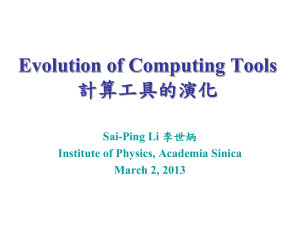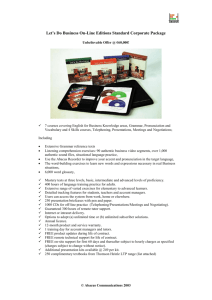Document 10834091
advertisement
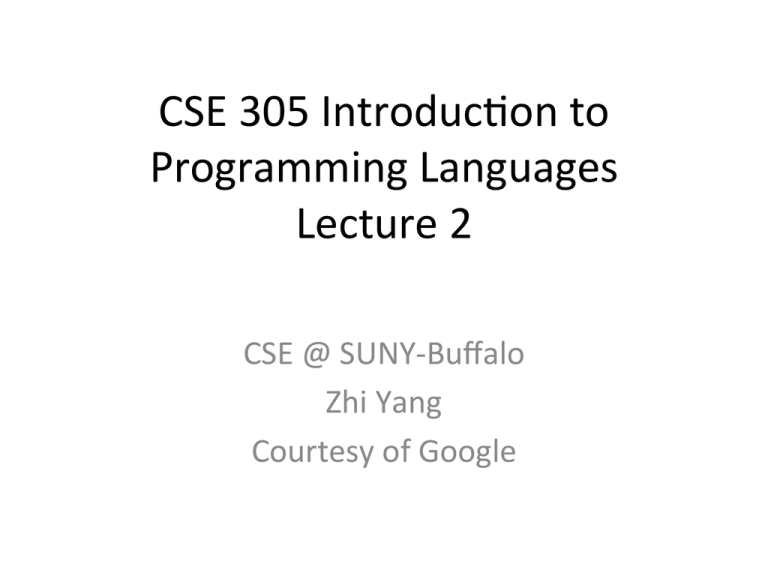
CSE 305 Introduc0on to Programming Languages Lecture 2 CSE @ SUNY-­‐Buffalo Zhi Yang Courtesy of Google No0ce • Lecture Time: • 10:00am -­‐ 12:05pm Clement 322 Recita.on Time: Bring your laptop if you can !~~~ • 12:10pm -­‐ 1:15pm Clement 322 We will be using recita0on 0me for explaining homeworks and answering ques0ons(you can grab your lunch at the recita0on 0me). We also give quiz! (but the quiz account for no points~~~) Office Hour: • If you have personal issue, just come, from the week of May27,every Friday 1:00 -­‐ 2:00 pm Davis 106 Bulle0n Board • We will be giving out homework half week before the lecture, so if you have any problem, you can use recita0on 0me in class ~~~ • For hw1, For division opera0on, what you need to get is quo0ent, and remainder ~~~ Let s start, recall last 0me abacus case • 1300 B.C.: Chinese use wire and beads to redesign abacus. The Chinese abacus shows similari0es to the Roman model. It is unclear which model influenced the other. • On the leb, you see two abacuses (abaci is also correct). On both abacuses, we see the number 1998. The top area of each abacus is used for fives, and the bofom area is used for ones. Abacuses are used for doing arithme0c. When doing arithme0c, you move the beads. The posi0on of the beads represents the sum, or product, so far. It is how you can remember the par0al sum or product. Experts in the use of the abacus can be very fast (and accurate), oben faster than an expert with a calculator, especially addi0on and subtrac0on. Such an expert on the abacus is especially adept at data entry. Ques0on: both Japanese and Chinese abacus are 10-­‐base, can we make a 2-­‐base abacus? For example, we want a 2-­‐based representa0on of 1998. • The Japanese abacus, the soroban, is more elegant, as the Chinese abacus has redundant beads. With the Chinese abacus, you never have to use the bofom bead in each column, in both the "ones" and "fives" areas. These extra beads are apparently useful, if you use an extra step every 0me you carry. You no0ce that you have all five beads up, so then you know you should execute a carry. Generaliza0on of Concept of Abacus • 1) First, yes, we can make a 2-­‐base abacus (Courtesy of Jim Loy) This is the number 1998. Let s do a calcula0on of 1998+232 like last 0me we did again . • 2) It looks like a modern concept of switches ~~~ Or a memory unit: OK, don t be in a hurry, let see how modern addi0on works • Let s summarize base-­‐2 addi0on (courtesy of Wikipedia): first number(A): 0 0 1 1 Second number(B): + 0 + 1 + 0 1 result: 0 1 1 0 carry: 0 0 0 1 Let s summarize, for result: for carry: So, we get conclusion: the result can be represented by a XOR gate, and the carry can be represented by an AND gate OK, what is a gate(BTW)? • A logic gate is an idealized or physical device implemen0ng a Boolean func0on, that is, it performs a logical opera0on on one or more logical inputs, and produces a single logical output:(courtesy of Wikipedia): Logic gate(Cont.) • Those are seven gates we will be using in hw1: So we do an 1-­‐bit base2 adder based on the unit of base2 abacus • So this 1-­‐bit base2 adder is called half adder(courtesy of Wikipedia): • In comparison, a full adder must consider the carry from previous level : Can I become lazier? First, recall what we call it 1-­‐bit full adder: So, we make a simpler version of 4 bit adder, what we call a Ripple-­‐Carry Adder: 4 bit Carry Look Ahead Adder • Below is the schema0c(courtesy of Professor Sam Kozai0s, sorry I am too lazy ~~~ ) It s 0me to get hand dirty: what is underline device for implemen0ng logic gates? • There is a history ~~~ or you can say, a real story ~~~ So we need a 2-­‐state electronic switches to represent our modern abacus The first inven0on is a electromagne0c relay (Courtesy of John Savard) Ques0on: If we want out to be high voltage(or 1), what are A, B, C, D, E respec0vely? Answer Logic: OUT = ABC + DE (no0ce above graph only give one combina0on of all possible inputs ~~~) Now, improvement: Vacuum Tube Well, a lifle more modern device ~~~ transistors ~~~ History of those devices ~~~ • • Howard Aiken (1944) The Mark I ,through a collabora0on with Harvard University, IBM, and the U.S. War Department, was developed to handle a large amount of number crunching. The complex equa0on solving that was needed to map logis0cs in the military was the driving force behind this project. ( The United States was at war with Germany.) The Mark I was the first automa.c calculator. It was not electronic, but did use electromagne0c relays with mechanical counters. It was said that when it ran the clicking sound was unbearable. Paper tape with hole punched in it provided the instruc0on sets, and the output was returned through holes punched in cards. • hfps://www.youtube.com/watch?v=qDaYDOJk6Rc Vacuum Tube • • J. Presper Eckert and John W. Mauchly (ENIAC, 1946 University of Pennsylvania) The ENIAC (Electronic Numerical Integrator and Calculator) was an electronic computer sponsored by the war department. It was classified because of war purposes. The ENIAC was so large that it took up a room ten feet high by about ten feet wide and several hundred feet in length. It could perform mul0plica0on in the 3/1000 of a second range. There were 18,000 vacuum tubes in the machine and instruc0ons had to be fed into the machine by way of switches because there was no internal memory within the machine. • hfps://www.youtube.com/watch?v=k4oGI_dNaPc Transistors ~~~ • From November 17, 1947 to December 23, 1947, John Bardeen and Walter Brafain at AT&T's Bell Labs in the United States, performed experiments and observed that when two gold point contacts were applied to a crystal of germanium, a signal was produced with the output power greater than the input. Solid State Physics Group leader William Shockley saw the poten0al in this, and over the next few months worked to greatly expand the knowledge of semiconductors. The term transistor was coined by John R. Pierce as a portmanteau of the term "transfer resistor”. According to Lillian Hoddeson and Vicki Daitch, authors of a biography of John Bardeen, Shockley had proposed that Bell Labs' first patent for a transistor should be based on the field-­‐effect and that he be named as the inventor. Having unearthed Lilienfeld’s patents that went into obscurity years earlier, lawyers at Bell Labs advised against Shockley's proposal because the idea of a field-­‐ effect transistor that used an electric field as a "grid" was not new. Instead, what Bardeen, Brafain, and Shockley invented in 1947 was the first bipolar point-­‐contact transistor. In acknowledgement of this accomplishment, Shockley, Bardeen, and Brafain were jointly awarded the 1956 Nobel Prize in Physics "for their researches on semiconductors and their discovery of the transistor effect.” • hfps://www.youtube.com/watch?v=b4TLAozsQyE Brief introduc0on to Verilog • Verilog, standardlized as IEEE 1364, is a hardware descrip0on language, it is most commonly used in the design and verifica0on of digital circuit and register-­‐transfer level of abstrac0on. • Go here hfp://en.wikipedia.org/wiki/Verilog
